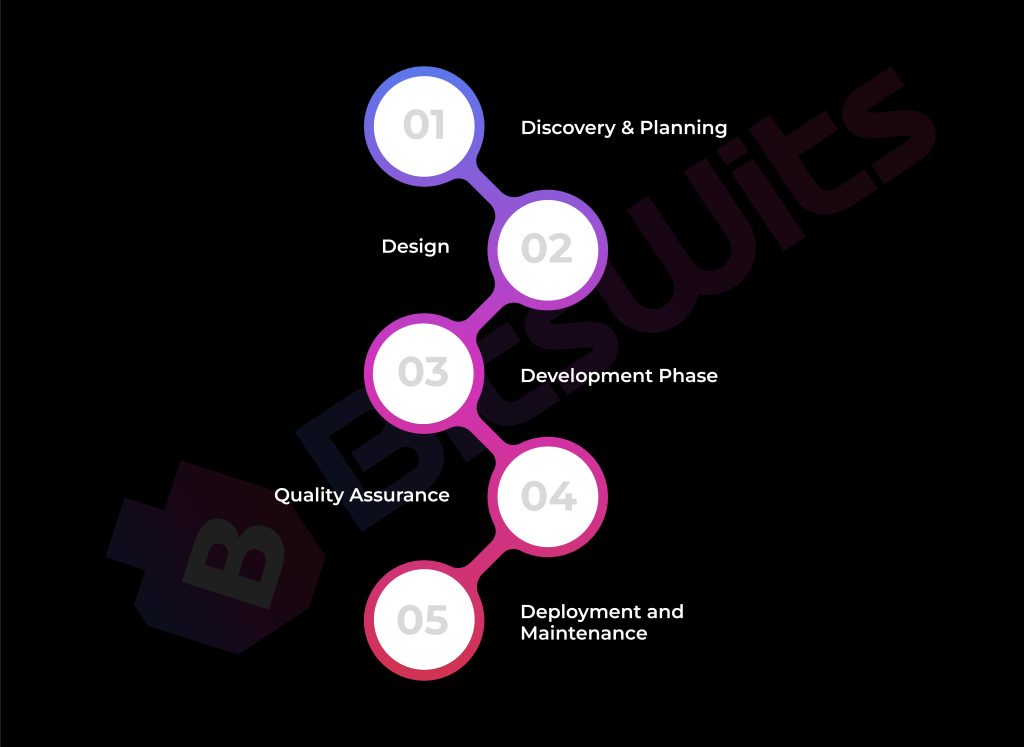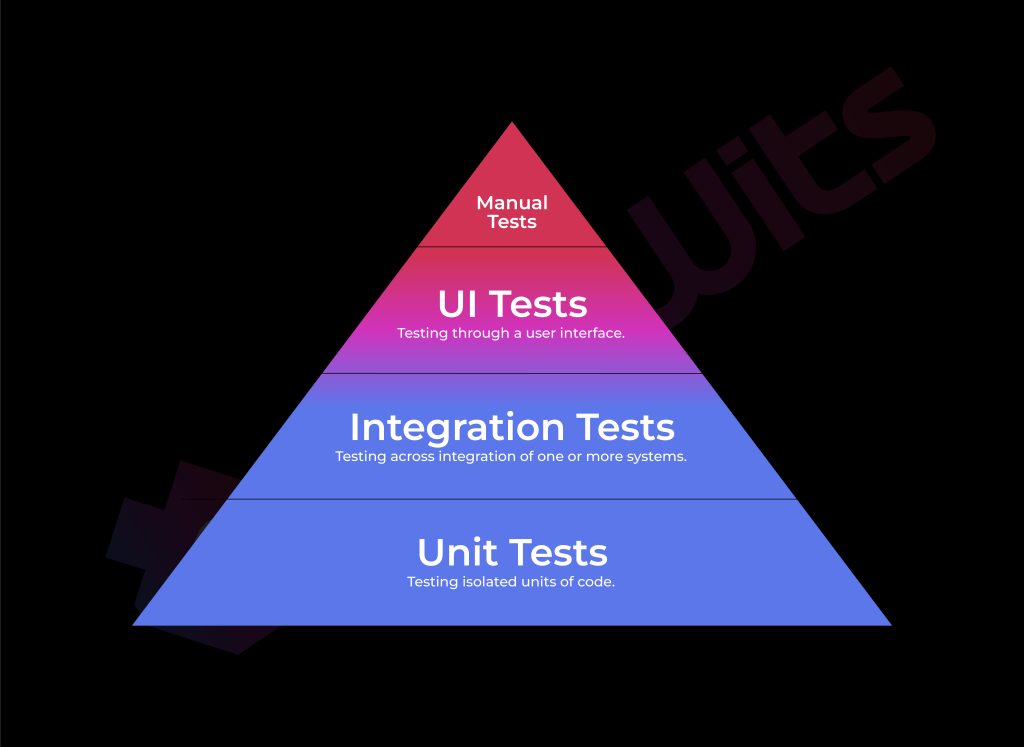Even though there is no universal formula for building an app, normally development teams follow some common stages known as the Application Development Life Cycle. If you’re looking to develop an app that users will love, it would be helpful for you to understand the basic principle of the application development lifecycle.
What is App Development Lifecycle?
The application development life cycle (ADLC) is the process of building applications that incorporate user requirements while calculating the risks involved ahead of time. It covers all phases of development: from requirements gathering to deployment, testing, and maintenance.
The process sets clear expectations, reduces errors, and helps you anticipate challenges. It enables organizations to create high-quality apps within budget while ensuring continuous optimization.
Why is the App Development Life Cycle Important?
Apps are no longer exclusive to tech-savvy industries; they are essential for every business. They streamline operations, support marketing efforts, and help retain customers. The life cycle of an app is important for a variety of reasons, including the following ones:
Clarity and Realism
It provides detailed insights into the entire development process, helping organizations set clear, realistic goals and timelines, hence ensuring all requirements are understood and met within specified deadlines.
Improved Planning
Structured steps in the lifecycle give team leaders an end-to-end view of the project, hence improving the planning and scheduling involved.
Project Control
The lifecycle framework simplifies tracking and controlling the development process, enabling organizations to schedule app releases effectively and maintain client satisfaction.
Standardization and Visibility
A standardized development framework stipulates every activity and deliverable, hence increasing transparency for all parties involved in the process.
Cost and Risk Management
Following the development cycle helps minimize project costs and reduce the risks associated with less structured production methods.
Timely Delivery
Accurate estimation of project timelines addresses common pitfalls in app development, potentially speeding up the development process.
Five Stages of App Development Life Cycle
Here are the essential app development stages that make up the foundation of any successful digital project.

1. Discovery & Planning
When you start a project, you might think you know exactly what it needs. But once you sit down with your developer, you’ll face a stream of critical questions: “How many different user roles should the app support? Which operating systems should it run on? What screen sizes should the design accommodate?” The discovery phase is essential to translate your vision into precise technical documentation.
- Competitor research: Understand what similar apps are offering.
- Feature mapping: Identify and prioritize the features your app needs.
- Technical requirements specification: Define the technical aspects and limitations.
- Setting costs and deadlines: Establish app development timeline and budget for the entire app project.
This phase is about gathering and classifying requirements from high-level to detailed, covering user, business, and essential system needs. After doing the above research, the following elements are described and documented:
- Performance objectives
- Failure prevention and fault analysis
- Frequency of data backup
- App usability, portability, accessibility, security, and recoverability
Businesses also allocate resources, plan capacities, schedule project timelines, identify risks, and outline mitigation strategies during this phase.
2. Design
The design phase of app development is where your app’s functionality meets its user-facing personality. Here, two key disciplines work together to create an experience that’s both beautiful and intuitive:
Designing UX
When creating UX mockups, it’s essential to consider the interface guidelines for each target platform, ensuring the app feels native and intuitive on every device. UX designing of an app consists of sketching and wireframing.
Sketch
Sketching is the initial step in designing an application. It is the phase where designers begin to envision and conceptualize the appearance and framework of an app. A designer roughly sketches to give a view of basically what the outline and flow of a similar app would be. This stage of the mobile development life cycle basically deals with brainstorming and visualization of the central idea of the app.
Wireframe
We move on to wireframing once a simple idea or concept is in hand. Wireframes are black-and-white models of every screen that focus on the layout and navigation and not on any distractions due to the color and detail of the content. These wireframes, often created using tools like Balsamiq, help in developing the user experience (UX) by mapping out the user journey through the app.
Designing UI
Once the UX has been fleshed out with wireframes and prototypes, it’s time to do the User Interface design. UI design is placing colors, graphics, and other graphical components onto wireframes. This process transforms black-and-white models into bright and catchy interfaces. Attention to detail is important in this process because the better the design of the UI, the more usable an app will be, and the greater its attractiveness to end-users.
It is worth mentioning that each platform has its own design language. For example:
- iOS: Apple Human Interface Guidelines emphasize simplicity and clarity.
- Android: Material Design guidelines from Google are based on tactile surfaces and bold graphic design.
- UWP: The Microsoft guidelines focus on flexibility and responsiveness in various devices.
Even with a consistent UX, the UI may differ across platforms to adhere to these guidelines, ensuring that the app feels native and intuitive to users on each platform. This stage is vital in the mobile app development life cycle.
Prototype
The final stage is prototyping. The prototype symbolizes the creation of a clickable model that looks like the final application without back-end functionality. It brings together all the elements of the design, providing a realistic preview of the app’s look and feel. Prototypes become extremely useful for presenting your app to potential sponsors or clients, showing how the real interface will work and flow.
Designing the UX and UI carefully creates an application that functions well, is easy to operate, and is visually appealing and engaging to users.
3. Development Phase
Now that the design phase is complete, it’s time to bring your app to life. This is where developers step in to turn the visual models into a fully functional product. The development process is crucial and involves coding all the necessary features to ensure the app works seamlessly.
The development process can be divided into two main parts:
Frontend Development
The front end refers to the user interface with which users interact. This ranges from layout and design to interactive elements on a website. A frontend developer would work on smoothness, and user-friendliness in the experience, and make sure the app is intuitive and a pleasure to the eyes.
Backend Development
The backend is the backbone of the app. All operations, calculations, and data management go through in the background. The development of the backend is conducted on the server side of an application and is focused on the reliability, security, and feasibility of handling any possible complex tasks within the app.

The frontend and backend development together make sure that not only the look of the application is nice but also the functionality is efficient enough to provide the user with a smooth and enjoyable experience.
4. Quality Assurance
QA is an integral part of the application development lifecycle, ensuring that your app is error-free and ready to roll out. Skipping or minimizing this step can lead to significant issues down the line. Proper testing is similar to proofreading a social media post for grammatical errors – that is where the quality comes in.
Importance of Testing
Proper testing should cover up to 90% of all potential risks, providing confidence in the app’s reliability and performance. This phase helps identify and fix bugs before the app is released, preventing negative user reviews and costly post-release fixes.
Types of Testing
To optimize the QA process, a combination of automated and manual tests is used:
Automated Testing
Automated tests are run by software tools to quickly check the app’s functionality. These tests can handle repetitive tasks efficiently, ensuring that the app performs well under various conditions.
Manual Testing
Manual tests involve human testers who explore the app’s features, providing insights into the user experience. This type of testing is essential for catching issues that automated tests might miss.

By thoroughly testing the app through both automated and manual methods, developers can ensure a high-quality product. Fixing bugs before release is always easier and more effective than dealing with them after the app is published and users have started leaving negative reviews.
Proper QA ensures that your app is reliable, user-friendly, and ready to make a positive impact once it hits the market.
5. Deployment and Maintenance
This involves running automated tests with the use of software tools to quickly check over the functionality of the app. These sorts of tests can repetitively perform their tasks efficiently and notice with good assurance how an app performs under different conditions.
The deployment and maintenance phase is crucial in ensuring your application functions optimally and remains up-to-date. This phase streamlines operations, reducing the time between app development and deployment, and ensures the app continues to perform well after release.
Deployment
Depending on the complexity and requirements of your app, deployment can be either manual or automated. In a test-driven development environment, the developers set up a deployment workflow that includes all the quality checks before devolving or deploying your app to end users. This careful process helps ensure the app is stable and ready for use.
Maintenance
After the application has been successfully launched, attention shifts to its maintenance. The app continues to require constant updating and maintenance so that it works smoothly. This will include:
- Bug Fixes: Locating and solving numerous issues that continually come up.
- Refining Code: Cleaning up and perfecting the code for improved performance and reliability.
- Enhancements: Implementing new features and improving the existing ones based on user feedback.
As users interact with the app, their feedback is invaluable for making necessary updates. This helps improve user satisfaction and retention by keeping the app relevant and user-friendly. Maintenance also ensures that the app adjusts to the shifting market conditions and business requirements so that it remains competitive and functional.
By prioritizing the above application development phases, developers can ensure their applications remain effective, efficient, and responsive to users’ needs.
Partner With Top US Mobile App Development Company
Over 150+ clients trust BitsWits for their app development Needs. Leverage Proven Expertise.
Hire Expert
What are the 6 Application Development Life Cycle Management Models?
Organizations use various models to guide their application development processes. While the waterfall and agile approaches are the most common, several other methodologies can also be employed. Let’s review some of the key models:
1. Waterfall Model
The waterfall model is a traditional and linear approach to application development. Each phase follows sequentially, similar to the flow of a waterfall. It’s a suitable choice when requirements are well-defined and unlikely to change.
Pros
- Clear and well-defined steps make it easy to release quality software at the end of the cycle.
- Easy to understand and follow with a negligible learning curve.
Cons
- Rigid structure that doesn’t allow for changes during an ongoing cycle.
- Testing and QA occur only at the end, making it difficult to address unexpected bugs.
2. Agile Model
The agile model is highly popular and widely used due to its flexibility. It involves delivering product value in stages and allows phases to overlap, which facilitates continuous improvement.
Pros
- Flexible and adaptable to new requirements throughout the development process.
- Continuous testing and customer feedback help identify and address issues early.
Cons
- Requires high levels of communication and coordination among team members.
- Continuous changes can lead to delaying project completion or compromising quality.
3. V-Shaped Model
The V-shaped model integrates testing into each phase of application development life cycle. It is similar to the waterfall model but includes corresponding testing stages.
Pros
- Testing at each development stage reduces the likelihood of errors in the final product.
Cons
- Rigid structure that makes it difficult to modify requirements once a phase is completed.
- Time-consuming and expensive testing process, especially for larger projects.
4. Iterative Model
The iterative model starts with vague requirements and builds the initial version of the app, improving it through successive releases.
Pros
- Ideal for projects that may require future changes, particularly large projects.
- Simplifies testing and releasing the application by delivering it in iterations.
Cons
- Not suitable for small projects or those with limited budgets.
- Frequent design changes due to incomplete requirements can complicate the process.
5. Spiral Model
The spiral model emphasizes risk analysis, prototyping, and evaluation steps. All these steps are incorporated into the development cycle itself.
Pros
- Early identification and mitigation of risks in the development phase.
- Testing and feedback at each phase lead to a better final product quality.
Cons
- Takes great expertise to analyze the risks accurately. Not all development teams possess such resources.
6. DevOps Model
DevOps is a relatively new model. Its focus is on collaboration among the Development and IT operations teams to enhance the speed and quality of software delivery.
Pros
- Increased collaboration and communication between the development and IT operations teams, therefore enhancing efficiency in work with diminished errors.
- Automation of manual processes in software delivery increases efficiency and reduces errors.
Cons
- Challenging to implement in large-scale organizations with legacy systems and teams.
- Requires investment in new tools and infrastructure, which can be costly.
Each of these models offers unique advantages and challenges, making them suitable for different types of projects and organizational needs. Choosing the right model depends on factors such as project size, complexity, and the need for flexibility and risk management.
Key Success Factors in the Mobile App Development Lifecycle
To launch a world-class mobile application, it’s essential to adopt top standards that guarantee success. With millions of mobile apps already on the market and many more to come, staying ahead of the competition requires a focus on relevant mobile technologies and best practices.
Here are four crucial factors to consider for ensuring world-class mobile app development:

1. User-Centric Approach
The success of your mobile application hinges on its appeal to users. Staying updated on user trends and continuously scaling your app to fit their interests can lead to significant turnovers. Leading market players like Jeff Bezos of Amazon and Mark Zuckerberg of Instagram attribute their success to launching and maintaining user-centric applications.
- Continuous Feedback Integration: Regularly collecting and integrating user feedback helps maintain a customer-centric approach and provides relevant services.
- Market and Competitor Analysis: Studying user trends and conducting competitor app analysis ensures you can dominate the market and attract new customers.
2. Cross-Platform Compatibility
Investing in a native app offers a super-immersive user experience, but if you’re scared of the development costs then cross-platform app development is the ideal choice to go for. It allows you to launch your app across multiple platforms, such as the Google Play Store and Apple App Store, enhancing distribution and accessibility.
Hybrid App Development Frameworks
- Using frameworks like React Native and Flutter, you can build phenomenal cross-platform apps that provide a consistent user experience across different platforms.
3. Security and Privacy
Data privacy is of utmost importance from a user perspective. With frequent data breaches in today’s cyber world, IT companies must ensure their mobile applications comply with data privacy policies.
- Latest Cyber Security Practices: Incorporating advanced security measures and technologies like Blockchain helps prevent data theft and app crashes.
- Building Trust: Developing a secure application builds trust with your customers, allowing them to use your services and purchase products with confidence.
4. Scalability
A software product that doesn’t evolve or grow over time is bound to collapse. According to market trends, you must scale your mobile app continuously.
- Choosing Scalable Frameworks: Select an app development framework that allows for easy scaling and customization with unlimited capabilities.
- Advanced Technologies: Leverage technologies like Blockchain, IoT, Metaverse, AR & VR, and Big Data to offer personalized services and stay ahead of the competition.
- Performance Goals: Plan timelines to scale your app consistently and measure performance goals to ensure ongoing success.
Final Thoughts
Application development is conducted in multiple stages and is always in the same sequence:
- Discovery — researching the market for a better understanding, specifying technical documentation, mapping features
- Design — sketching, creating wireframes, making mockups
- Development — writing front-end and back-end code
- Testing and QA — checking that the app works as planned and passes a quality threshold
- Deployment & Maintenance — publishing an app in a store, technical support, and further software development.
Now that you have a clear idea of the mobile application development life cycle and the various processes involved, it’s essential to choose the right company to build your app. Partnering with a leading mobile app development company like BitsWits can ensure you receive world-class development services, from full-fledged app development to strategic consultation.
FAQs












